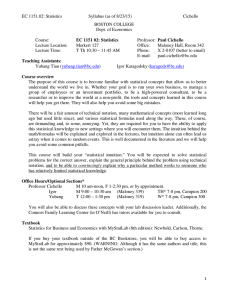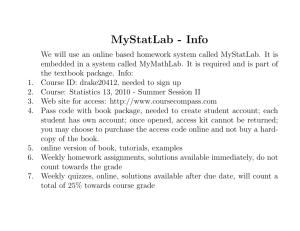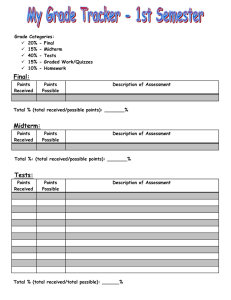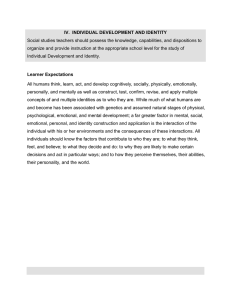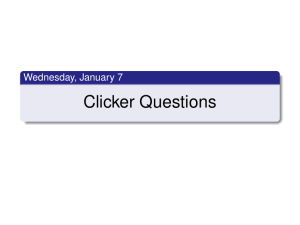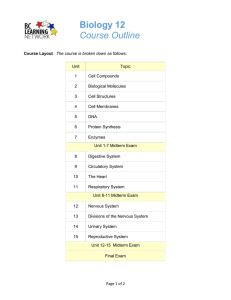EC 1151.02: Statistics Syllabus (as of 1/7/16) Cichello BOSTON COLLEGE
advertisement
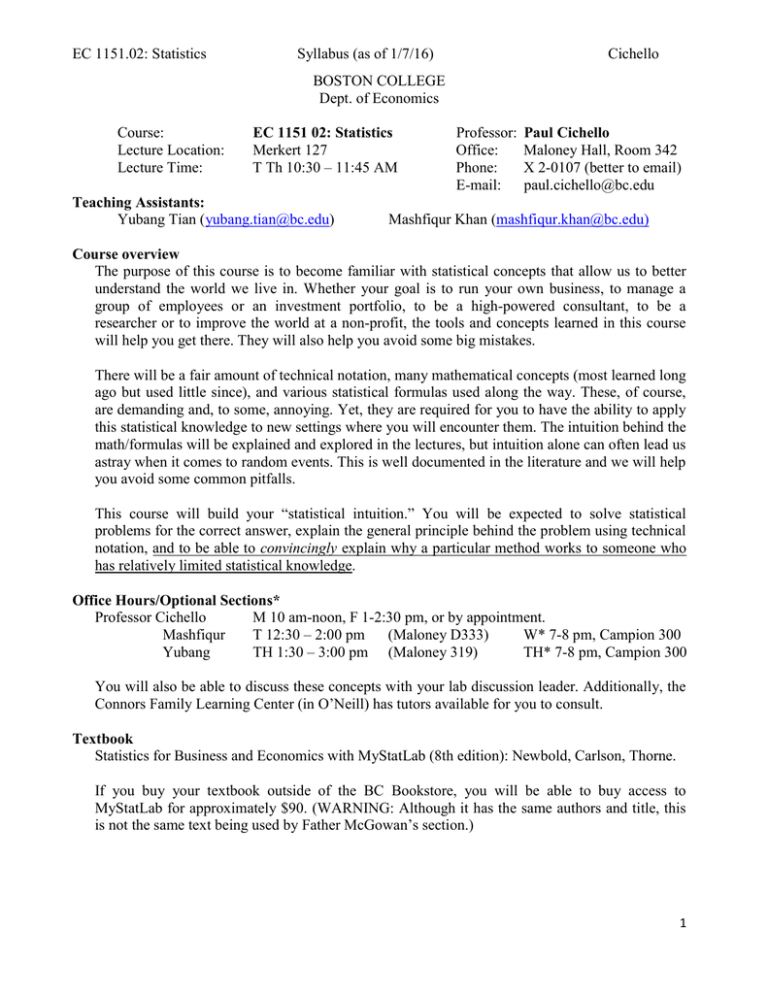
EC 1151.02: Statistics
Course:
Lecture Location:
Lecture Time:
Syllabus (as of 1/7/16)
Cichello
BOSTON COLLEGE
Dept. of Economics
EC 1151 02: Statistics
Merkert 127
T Th 10:30 – 11:45 AM
Teaching Assistants:
Yubang Tian (yubang.tian@bc.edu)
Professor:
Office:
Phone:
E-mail:
Paul Cichello
Maloney Hall, Room 342
X 2-0107 (better to email)
paul.cichello@bc.edu
Mashfiqur Khan (mashfiqur.khan@bc.edu)
Course overview
The purpose of this course is to become familiar with statistical concepts that allow us to better
understand the world we live in. Whether your goal is to run your own business, to manage a
group of employees or an investment portfolio, to be a high-powered consultant, to be a
researcher or to improve the world at a non-profit, the tools and concepts learned in this course
will help you get there. They will also help you avoid some big mistakes.
There will be a fair amount of technical notation, many mathematical concepts (most learned long
ago but used little since), and various statistical formulas used along the way. These, of course,
are demanding and, to some, annoying. Yet, they are required for you to have the ability to apply
this statistical knowledge to new settings where you will encounter them. The intuition behind the
math/formulas will be explained and explored in the lectures, but intuition alone can often lead us
astray when it comes to random events. This is well documented in the literature and we will help
you avoid some common pitfalls.
This course will build your “statistical intuition.” You will be expected to solve statistical
problems for the correct answer, explain the general principle behind the problem using technical
notation, and to be able to convincingly explain why a particular method works to someone who
has relatively limited statistical knowledge.
Office Hours/Optional Sections*
Professor Cichello
M 10 am-noon, F 1-2:30 pm, or by appointment.
Mashfiqur
T 12:30 – 2:00 pm
(Maloney D333)
W* 7-8 pm, Campion 300
Yubang
TH 1:30 – 3:00 pm (Maloney 319)
TH* 7-8 pm, Campion 300
You will also be able to discuss these concepts with your lab discussion leader. Additionally, the
Connors Family Learning Center (in O’Neill) has tutors available for you to consult.
Textbook
Statistics for Business and Economics with MyStatLab (8th edition): Newbold, Carlson, Thorne.
If you buy your textbook outside of the BC Bookstore, you will be able to buy access to
MyStatLab for approximately $90. (WARNING: Although it has the same authors and title, this
is not the same text being used by Father McGowan’s section.)
1
EC 1151.02: Statistics
Syllabus (as of 1/7/16)
Cichello
Grading
Your course grade will be determined using the following grading scheme:
Lab (including lab assignments):
20 %
Participation (including graded problem sets):
8%
10 Minute Quizzes:
8%
Midterm 1:
16 %
Midterm 2 (cumulative):
16 %
Final Exam (cumulative):
32 %
Mandatory Lab Sections
In addition to lecture, you will attend a lab once a week. The lab work and assignments will be
incorporated into your final course grade. In the lab, you will learn how to use STATA- a
statistical software package- and apply the concepts learned in lecture. Details on how to access
STATA will be presented in lab.
Problem Sets
Problem sets from class will consist of two portions: a graded portion, which is more mechanical,
and an ungraded portion, which includes more conceptual questions.
- The graded portion will be completed online (and automatically graded) using MyStatLab.
- The ungraded portion will include conceptual questions (or parts of questions) that are more
reflective of the difficulty of the exam questions. You will not turn these in. Solution sets will
be made available. I strongly encourage you to work together with a study partner on these
more conceptual questions.
10 Minute Quizzes
There will be five to eight 10-minute quizzes throughout the semester. These are meant to test
your understanding of the basic terms and methods discussed in the previous week’s lectures. I
will be clear about what topics might be tested on the quiz. Each quiz will have 1 question (worth
1 pt.) that will be straight-forward and 1 question (worth .5 pts.) that may be slightly tougher
and/or refer to material from previous weeks. Your quiz grade will be determined as follows:
1 n
Quiz grade = MIN{ si ,1} *100 where si is the score on quiz i (of n quizzes).
n i 1
Participation
Your participation grade is determined in equal parts by:
- attending class (measured by I>clicker responses);
- completing graded problem sets on MyStatLab (described previously); and
- your performance on these graded problem sets.
Exams
Exams will be closed book. I will provide a formula cheat sheet as well as any statistical tables
you will need. I will post those cheat sheet/tables in advance.
Examination Make-up Policy
The following policy will be strictly enforced:
(1) you must obtain my approval before the exam or you will be penalized.
(2) There will be no make-up exams for either midterm. If you miss a midterm exam, the
weight assigned to that exam will be distributed over the remaining exams.
2
EC 1151.02: Statistics
Syllabus (as of 1/7/16)
Cichello
Classroom Technology
Canvas: Class handouts, problem sets, problem set solutions, announcements and other material
will be posted on the course website on Canvas.
I>Clicker: We will be using I>Clicker in the classroom. Every student must buy a clicker from
the bookstore (if you do not already have one). You must register your I>Clicker on AGORA
(even if you have registered it for a previous course). Your attendance, measured via I>Clicker
responses, will affect your participation grade.
Notes on Class Structure
1. Lecture handouts will be posted on Canvas prior to class. It is the responsibility of the student
to download these lecture notes and bring them to class. I will post my slides after class.
2. I will often post additional post-class handouts that will help you walk you through some of
the material we have covered in class. A thorough understanding of these handouts is critical
for you to perform well in this class.
3. I will also have a question or two on MyStatLab corresponding to the topic covered each day.
The post-class questions are optional but give you a chance to walk through a basic problem
on the topic covered. (Exam questions may be considerably more difficult. See ungraded
problem sets.)
Academic Integrity
Cheating on any exam will result in
(1) an automatic failure in the course and
(2) reporting the incident to the College of Arts and Sciences as required by the University.
See http://www.bc.edu/publications/ucatalog/policy.shtml#integrity for a full discussion of the
university’s policies and procedures regarding academic integrity.
Accommodations for Learning Disabilities
If you have a learning disability, you are strongly encouraged to request accommodations for this
course. Exams are lengthy and have some time pressure. Please register with either Kathy Duggan
(dugganka@bc.edu) Director, the Connors Family Learning Center (learning disabilities and
ADHD) or Paulette Durrett (paulette.durett@bc.edu), Assistant Dean for Students with
Disabilities (all other disabilities). Advance notice and appropriate documentation are required for
accommodations.
Note on the flu and other illnesses
If you are out sick, please email me a note from the medical center/doctor. I can adjust your
participation score accordingly. You should get notes from a classmate and keep up with the
homework to the extent possible. You should also expect to come to office hours to review any
questions you have when you feel better. Please feel free to ask me for an extension on problem
sets if you cannot keep up due to the illness. Also, please be pro-active in contacting me when it
comes to missing exams. (See Examination Make-up Policy section above.)
3
EC 1151.02: Statistics
Date
1/19
1/21
1/26
1/28
2/2
2/4
2/9
2/11
2/16
Syllabus (as of 1/7/16)
Tentative Schedule
Topic
How to Fast Track Your Career
Introductions; Summation Notation
The SI Jinx & why alumni can’t get their kids into BC!
Regression to Mean
How did you choose where to apply to college?
How much do you think you will make after college?
Descriptive Statistics: Measures of Central Tendency;
Percentiles; and Histograms; (Weighted Means)
Re-centering (and re-scaling) your world
Variance, Standard deviation; z-scores
Why do Colleges care about SAT scores?
Why does BC pay the football coach so much?
Are we in danger of the 3rd thing???
Covariance and Correlation
Who is going to the Homecoming Concert?
Probability Basics; Conditional Probabilities
Who is going to the Homecoming Concert? Was Race a
Factor in Voting in Boston’s 2013 Mayoral Race?
Conditional Probabilities; Independence; Venn Diagrams
Should we screen for breast cancer?
Statistical Independence; Bayes Rule
How do casinos make money? Why do insurance
companies exist? Why do the rich get richer?
Expected Values and Variances of Discrete Random
Variables and Linear Functions of Discrete Random Vars.
What if all beer tastes the same?
Binomial Random Variables
How to Manage Risk
Joint Distributions and Discrete Random Variables
Avoiding common statistical traps:
Missing Airplanes, The SI Jinx, Convicting on DNA
evidence, In OJ’s defense, Short Breaks Cause Cancer
Selection Bias, Regression to Mean, Multiple Tests,
Improper Conditioning, Correlation ≠ Causation (3rd thing)
2/18
First Midterm
2/23
Are you Happy? Understanding Responses in the age of
the internet….The World is Normal? (lots of examples)
Continuous Random Variables: Uniform Distribution, The
Standard Normal Distribution
The World is Normal
Probabilities for all other Normal Distributions
Italian Fest! Business application w/ Normal distributions
Return to Schlitz Marketing Campaign?
Binomial as Normal
2/25
3/1
Cichello
Chapter
1.1-1.4
Ch 1 DW*
1.5; 1.6; 6.1; 2.1; (2.3)
2.2; 2.4
2.4; 3.1-3.3
3.1-3.4
3.4-3.5
3.4, 3.5
4.1-4.3
Ch. 5 NS*
4.4; 4.7; (4.5; 4.6)
pp. 68-71 NS*
Ch 6 NS*
5.1, 5.2, 5.3, 5.6
Ch. 8 DW*
5.3
5.3, 5.4
4
EC 1151.02: Statistics
3/3
3/15
3/17
3/22
3/29
3/31
4/5
4/7
4/12
4/14
4/19
4/21
4/26
4/28
5/3
5/5
5/10
Syllabus (as of 1/7/16)
Where are we anyway?
Distribution of Sample Means from a Normal Distribution
How to catch cheaters and shysters! From schools to
sports to Wall Street to business
Central Limit Theorem and Distribution of Sample Means
SPRING BREAK
Cichello
6.1, 6.2
Political Polls (Coakley vs. Baker) and Gambling
Proportions
Taking the Pulse of South Africa
Estimation: Single Population; Normal Distributions,
Confidence Intervals
Food Shares in SA/Assessing claims (on the internet)
Hypothesis Testing; Two-tailed and one-tailed tests;
Normal distribution with known variance
6.3
Food Shares in SA/Assessing claims, pt. 2
Hypothesis testing: Normal distribution with unknown
variance; t-distributions
Sex education in Ecuador
Hypothesis testing: large sample or proportions
What’s up with my Soda?
Distribution of Sample Variances of a Normal distribution
(χ2 distribution); Confidence Interval and Hyp. Testing
7.3; 9.3
Sex Education in Ecuador pt. 2
Multiple populations: Distribution and Hypothesis Testing
Catching cheaters at low cost: Consulting Problem
Power of a test
More than Correlation: Identifying Meaningful Impacts
Overview of Linear Models; Linear Regression Models
The Return of Inference! (and Covariance)
Least Squares Model, R-squared and Standard errors
It’s a Non-linear world: Viral growth and standard
economic theory
Log functional forms
Gender Discrimination in Thailand?
Dummy Variables and Regression as a conditional mean
What about here at home? Addressing that 3rd thing
Multiple Regression, partial derivatives, and quadratic
functional forms
Course Overview; Review for final
Ch.8; Ch. 10.1-10.3
Easter Break
Second Midterm
7.1, 7.2
9.1, 9.2
7.4; 9.4
6.4; 7.5; 9.6; 10.4
7.7; 7.8; 9.5; 10.5
11.1-11.3
11.4-11.5
handout
Handout; 12.1, 12.3,
12.8
12.4; 12.7
FINAL EXAM: 9:00 am – noon
DW* refers to Leonard Mlodinow’s The Drunkard’s Walk: How Randomness Rules Our Lives.
NS* refers to Charles Wheelan’s Naked Statistics.
Chapters from DW* and NS* will be made available on Canvas.
5
